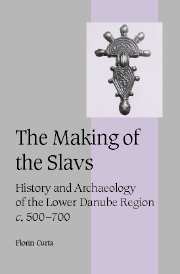Book contents
- Frontmatter
- Contents
- List of figures
- List of tables
- Acknowledgments
- List of abbreviations
- Introduction
- 1 Slavic ethnicity and the ethnie of the Slavs: concepts and approaches
- 2 Sources for the history of the early Slavs (c. 500–700)
- 3 The Slavs in early medieval sources (c. 500–700)
- 4 The Balkans and the Danube limes during the sixth and seventh centuries
- 5 Barbarians on the sixth-century Danube frontier: an archaeological survey
- 6 Elites and group identity north of the Danube frontier: the archaeological evidence
- 7 “Kings” and “democracy”: power in early Slavic society
- Conclusion: the making of the Slavs
- Appendix A
- Appendix B
- References
- Index
- Cambridge Studies in Medieval Life and Thought Fourth series
2 - Sources for the history of the early Slavs (c. 500–700)
Published online by Cambridge University Press: 08 July 2009
- Frontmatter
- Contents
- List of figures
- List of tables
- Acknowledgments
- List of abbreviations
- Introduction
- 1 Slavic ethnicity and the ethnie of the Slavs: concepts and approaches
- 2 Sources for the history of the early Slavs (c. 500–700)
- 3 The Slavs in early medieval sources (c. 500–700)
- 4 The Balkans and the Danube limes during the sixth and seventh centuries
- 5 Barbarians on the sixth-century Danube frontier: an archaeological survey
- 6 Elites and group identity north of the Danube frontier: the archaeological evidence
- 7 “Kings” and “democracy”: power in early Slavic society
- Conclusion: the making of the Slavs
- Appendix A
- Appendix B
- References
- Index
- Cambridge Studies in Medieval Life and Thought Fourth series
Summary
Much of what we know about sixth- and seventh-century Slavs comes from works of contemporary authors writing in Greek and, to a lesser extent, in Latin or Syriac. The majority did not pay special attention to the Slavs, but simply mentioned them and a few other things about them in connection to events relevant to the history of the Empire. Some were accounts of eyewitnesses, but most were written long after the event or at a considerable distance. Their coverage is patchy, and the basic narrative has to be reconstructed from a wide variety of standpoints and perspectives. This chapter will examine some of the issues concerning authorship, trustworthiness, and dating, which might be relevant for the image of the Slavs resulting from early medieval sources. The following chapter will take into consideration the image which is often derived from these accounts.
PROCOPIUS AND JORDANES
Procopius was often viewed as the voice of the senatorial opposition to Justinian's regime. He is believed to have addressed an audience still fond of Homer, Herodotus, and Thucydides. His description of the Slavic god as the “maker of lightning” (τòν τñς ἀστραπτñς δημιουρϒόν ) is indeed reminiscent of Sophocles. The episode of the “phoney Chilbudius” betrays the influence of the neo-Attic comedy and, possibly, of Plautus. There is also a weak echo of Thucydides where Procopius claims that he had written about buildings which he had seen himself, or heard described by others who had seen them.
- Type
- Chapter
- Information
- The Making of the SlavsHistory and Archaeology of the Lower Danube Region, c.500–700, pp. 36 - 73Publisher: Cambridge University PressPrint publication year: 2001



